Sports et divertissements: a unique resource for researchers in design history
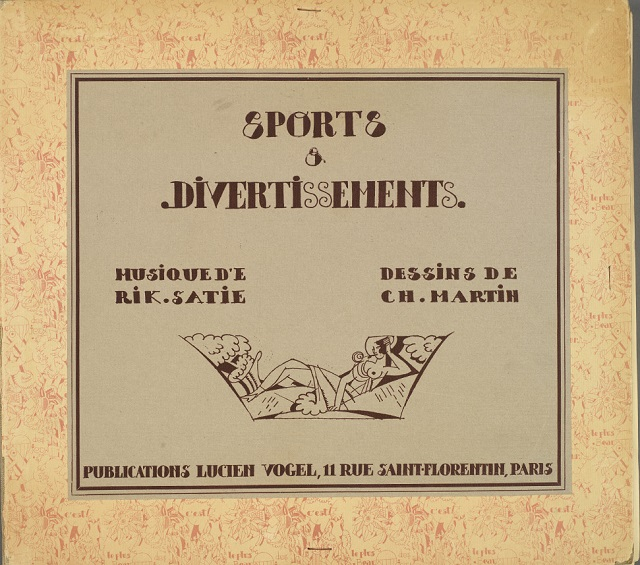
Post by Ketzia Sherman
The ROM Library & Archives recently acquired a rare copy of Sports et divertissements, a musical score by Erik Satie with pochoir illustrations by Charles Martin, hand-coloured by Jules Saudé (Paris: Publications Lucien Vogel, [1923]).
Sports et divertissements is a captivating album combining twenty brief piano pieces with humorous text and corresponding illustrations.
Erik Satie was a French composer and pianist known for an eccentric, avante garde compositional style. Satie was sometimes referred to as the “Velvet Gentleman,” as he insisted his wardrobe consist entirely of grey velvet or corduroy suits (Potter 66). His work was equally as eccentric as his dress.
Satie primarily concerned himself with the ‘exteriorization’ of his musical thought in print, rather than performance. His work is unique in its bar-less but regularly metered scores, lack of repeated clefs and amusing yet irrelevant comments to the performer. These qualities may have been bizarre to the public, but they exemplified Satie’s goal of creating sheet music which was “as striking as literary or artistic publications” (Potter 7).
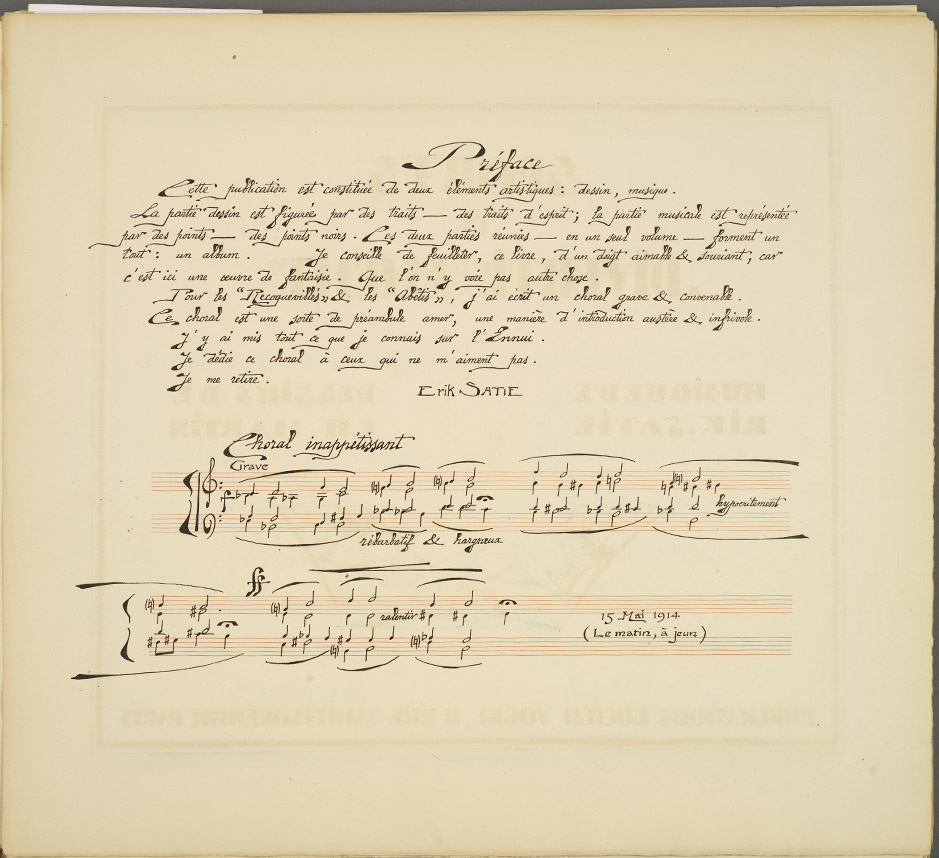
Preface to Sports et divertissements by Erik Satie. Royal Ontario Museum, Rare Book M25 .S27 S7 1923 (Image: ROM2017_15496_2)
Satie often explored various ways of integrating high art— as represented by the learned techniques and forms of French art music, along with the idealized qualities of clarity, simplicity, and structural balance (Davis 432). His integration of high and low culture culminated in Sports et divertissement.
The musical scores in Sports et divertissement were accompanied by satirical commentary, looking down upon academic ‘elitist’ music. He writes in the preface, “For the Dried Up & Stultified I have written a Chorale which is serious & respectable. This Chorale is a sort of bitter preamble, a kind of austere & unfrivolous introduction. I have put into it everything I know about Boredom. I dedicate this Chorale to those who do not like me. I withdraw." Throughout the compositions, he interjects the music with humorous instructions such as, “Moderately & with great boredom” (Satie).
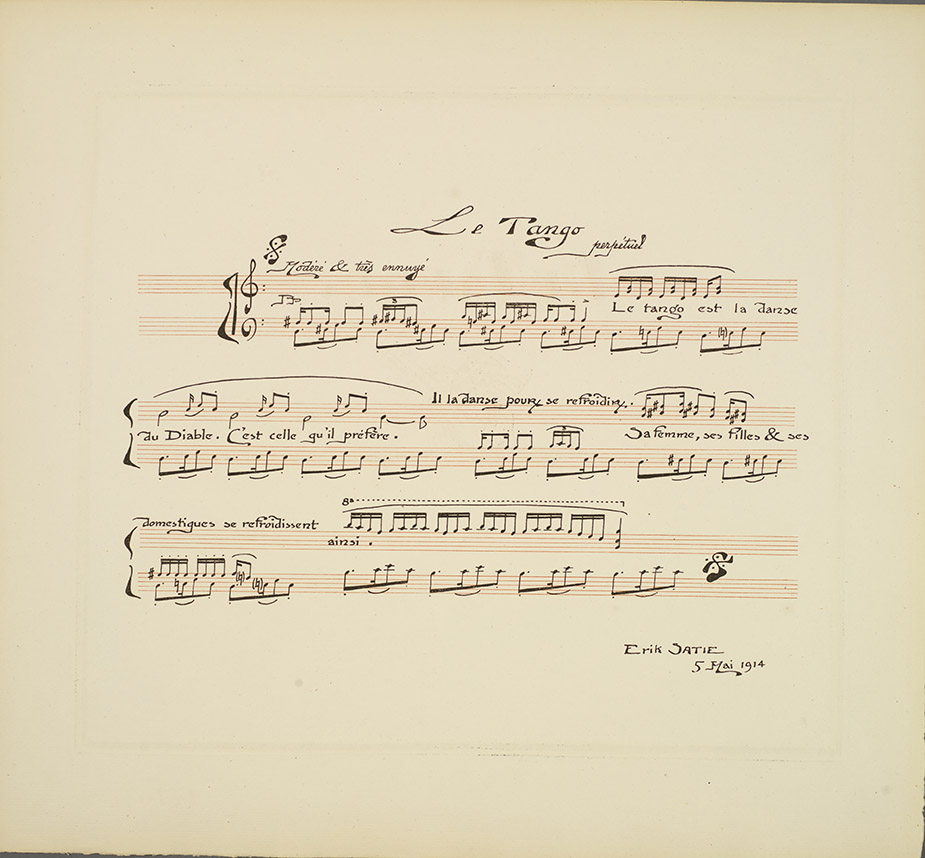
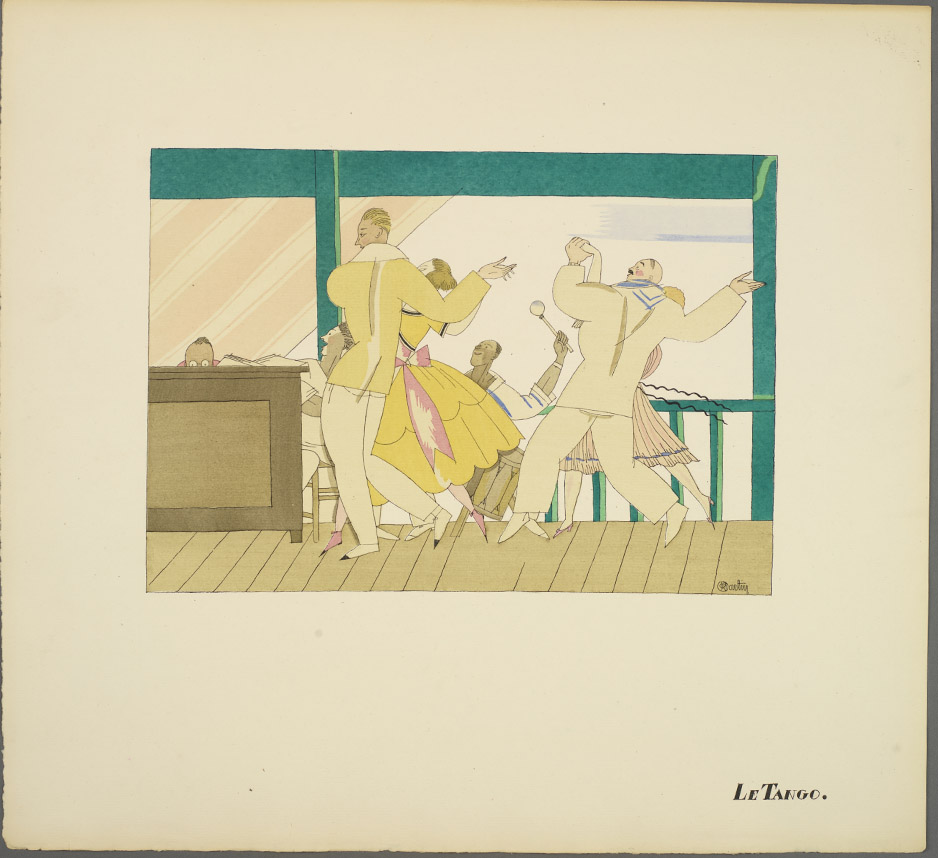
“Le tango” – musical score by Erik Satie (5 May, 1914); illustration by Charles Martin, hand-coloured by Jules Saudé (1923). Royal Ontario Museum, Rare Book M25 .S27 S7 1923 (Images: ROM2017_15496_9 and ROM2017_15496_10)
The pages of this album however, embody high culture. Oversized, bound in heavy paper and backed by flyleaves in an art deco motif, it embodies luxury. Each of the twenty full page illustrations are hand coloured by Jules Saudé using the labour intensive pochoir stencilling process.
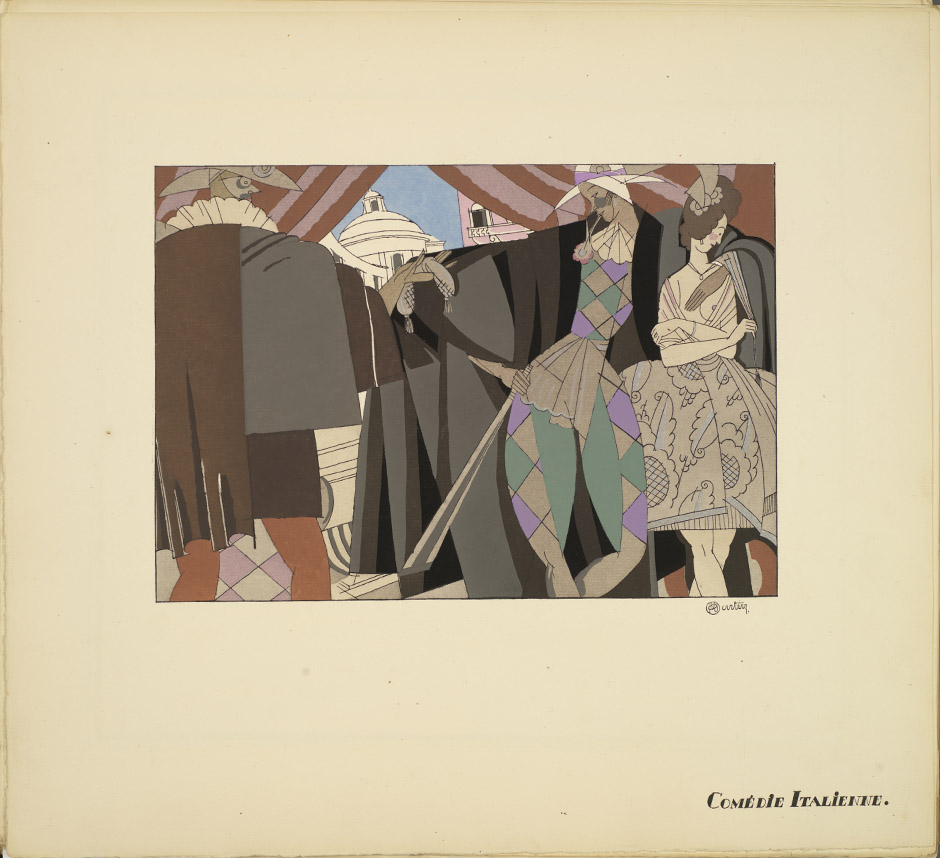
“Comédie Italienne”, illustration by Charles Martin, hand-coloured by Jules Saudé. Royal Ontario Museum, Rare Book M25 .S27 S7 1923 (Image: ROM2017_15496_4)
The Illustrations, by one of the era’s most sought-after illustrators Charles Martin, merge music with fashion to reveal a glimpse into the lifestyle deemed modern and fashionable during the early twentieth century. Martin spent almost his entire career in the sphere of popular culture and commercial art. He made his reputation at the Gazette du Bon Ton, where Lucien Vogel employed him. His work was celebrated for its “Charm, fantasy, humour and irony” (Davis 446). Sports et divertissements was originally conceived as a deluxe collector’s album. Lucien Vogel, publisher of the popular fashion magazine, Gazette du Bon Ton, commissioned the work. Its style, combining multiple artistic mediums was a common form for published work among the French elite. Upper class French connoisseurs and art-collectors frequently collected these livre d’artistes— luxurious books of pictures, words and sometimes music (Davis 440).
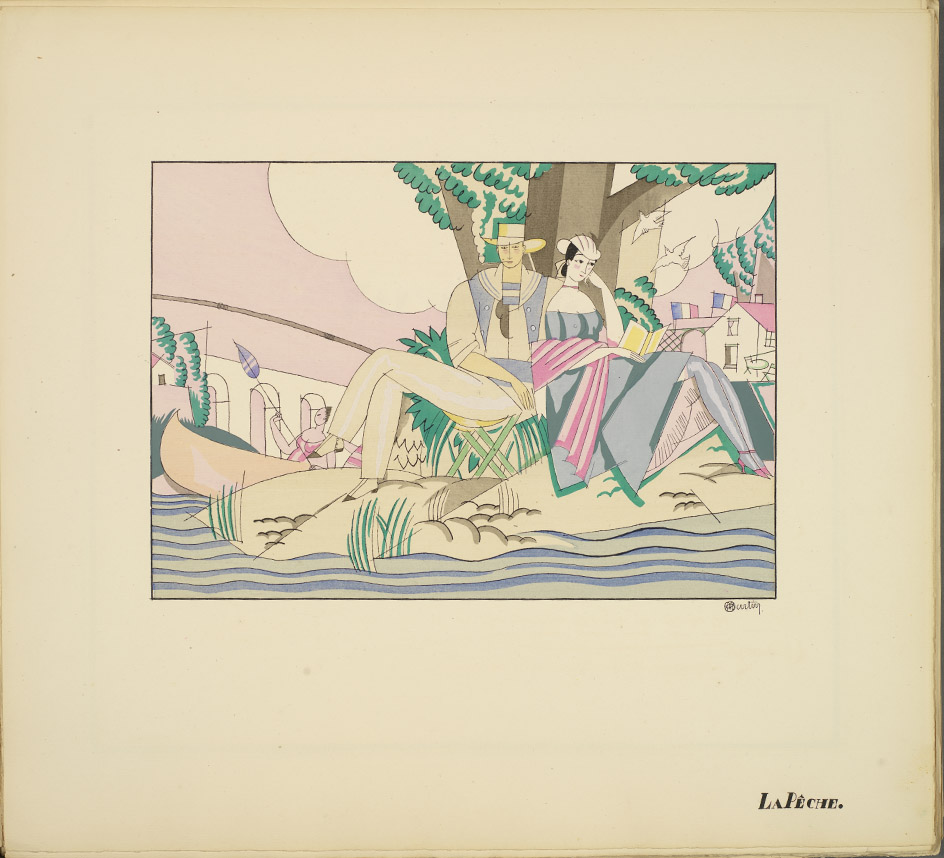
“La pêche”, illustration by Charles Martin, hand-coloured by Jules Saudé. Royal Ontario Museum, Rare Book M25 .S27 S7 1923 (Image: ROM2017_15496_6).
Martin's illustrations transport viewers into a world of fashion and luxury, rendered in the strong geometric shapes and bold colours that are emblematic of Art Deco. He mirrors Satie’s humour with playful illustration, unlike most traditional fashion illustrations of the period.
The combination of energetic illustration, lighthearted compositions, and the humorous texts inscribed throughout the scores imbues the project with the feeling of play. Sports et divertissements is a strong example of the early 20th century Avante Garde's interest in creating works of art that synthesized music, language, and visual art (Davis 440). The illustrations and compositions have been called “surrealistic sketches” and compared to Japanese haiku (Gillmor 31).
The album originally began production in 1914, however it would not be released until 1923. Prior to printing the album, World War I intervened. Fashion couturiers closed their doors, magazines halted production and frivolity was abandoned for the reality of war. The Jazz age of the 1920s however brought luxurious frivolity back to Paris, giving Sports et Divertissements a second chance. While the musical scores remained, new illustrations were commissioned from Charles Martin to reflect the current artistic environment rather than the dated fashions of 1914.
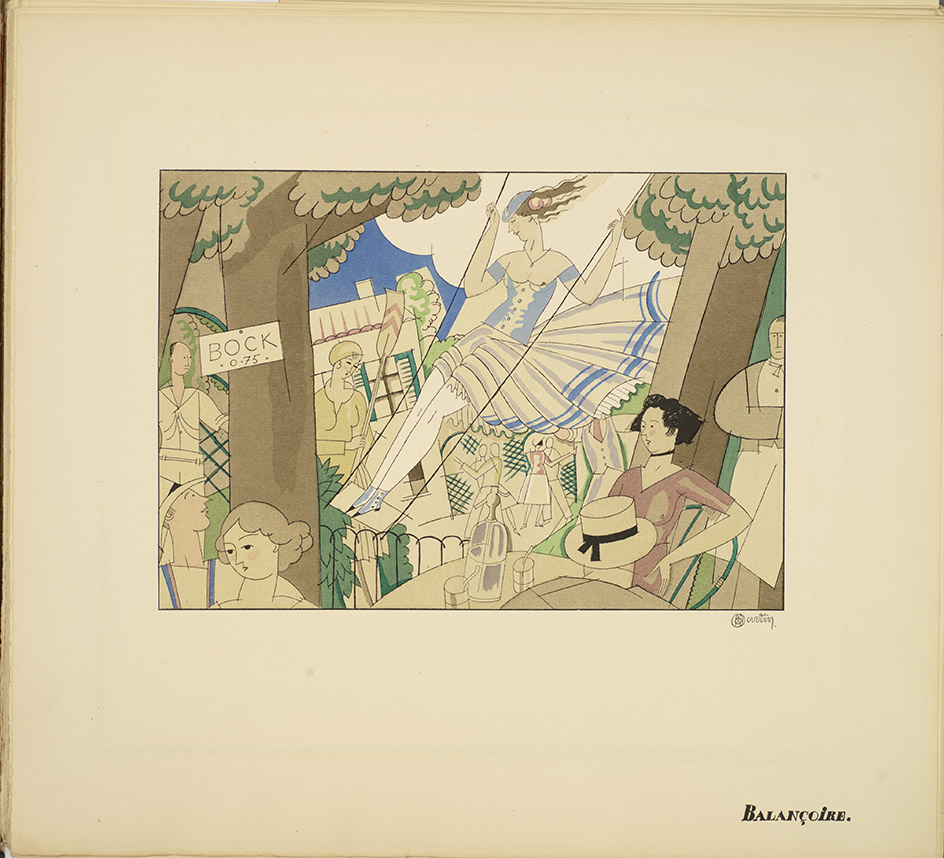
“Balançoire”, illustration by Charles Martin, hand-coloured by Jules Saudé. Royal Ontario Museum, Rare Book M25 .S27 S7 1923 (Image: ROM2017_15496_3).
Satie himself did not wish for the piece to be taken too seriously. The preface, written by Satie, explains: “This publication is made up of two artistic elements: drawing, music. The drawing part is represented by strokes – strokes of wit; the musical part is depicted by dots – black dots [i.e., blackheads]. These two parts together – in a single volume – form a whole: an album. I advise the reader to leaf through the pages of this book with a kindly & smiling finger, for it is a work of fantasy. No more should be read into it.”
Sports et divertissements suffered from relative obscurity in postwar France. Initial response to the work was muted as a result of the limited nature of its original publication. When the first commercial performing edition was released in 1926, Satie had died and his reputation as a composer was all but shattered with the critical reception of his last work, the Dada ballet Relâche (Hanlon 74). In the English-speaking world, the piece received its first significant boost after World War II from Rollo H. Myers' biography of Erik Satie (1948), in which he ranked Sports with a handful of Satie compositions that are "outstanding and cannot be ignored by any student of contemporary music.” (Myers 87).
Sports et divertissements is a unique merger of music and fashion with Satie’s piano and the precise lines of pochoir in Martin’s cubist style. The acquisition of this rare score further solidifies the ROM Library & Archives as a rich resource for researchers in design history, complementing the Library’s rare book collections of artists’ books and fashion magazines and plates from the early 20th century. This acquisition ties into the ROM’s collection of textiles and costumes, directly relating to the Charles Martin sketch from the same era for Bianchini-Férier (see: Ananas, ROM 2002.14.1.6). It also greatly enhances our current holdings of fashion plates, Art Deco pochoir plates by E. A. Seguy, Georgie Barbier, and Pablo Picasso, and the complete run of La Gazette du Bon Ton, while also providing an opportunity for connecting the ROM to the international and local music community.
Ketzia Sherman is a Toronto-based researcher, illustrator, and textile artist. She has a Bachelor degree in Fashion Communication and is a Master's candidate at Ryerson University studying the Arts of Fashion.
Sources cited
Davis, Mary E. "Modernity à La Mode: Popular Culture and Avant-Gardism in Erik Satie's "Sports et divertissements.”” The Musical Quarterly: 1999: 430-73. Web.
Davis, Mary E. Erik Satie. Reaktion Books, 2007. Print.
Gillmor, Alan M. "Musico-poetic Form in Satie's "Humoristic" Piano Suites (1913-14)" Canadian University Music Review: n. 8, 1987:31. Print.
Hanlon, Ann-Marie. Satie and the French Musical Canon: a reception study. Thesis. Newcastle University, 2013. Print.
Myers, Rollo H. Erik Satie. Dover Publications, Inc, New York: 1968. Print.
Potter, Caroline. Erik Satie: music, art and literature. Ashgate, 2013. Print.
Satie, Erik. Sports et divertissement. Dessins de Ch. Martin. Gravés sur cuivres et rehaussés de pochoir par Jules Saudé. Paris: Publications Lucien Vogel, [1923]. Print. Royal Ontario Museum Library & Archives. Rare Oversize M25 S27 S7 1923. ROM copy is numbered 159.
